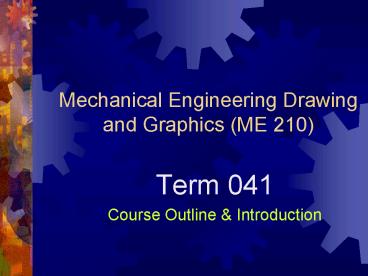Mechanical Engineering Drawing and Graphics ME 210 - PowerPoint PPT Presentation
1 / 12
Title:
Mechanical Engineering Drawing and Graphics ME 210
Description:
The members of the engineering design project team must be able to communicate ... Newer CAD systems are becoming more user friendly, but one should not ... – PowerPoint PPT presentation
Number of Views:201
Avg rating:3.0/5.0
Title: Mechanical Engineering Drawing and Graphics ME 210
1
Mechanical Engineering Drawing and Graphics (ME
210)
- Term 041
- Course Outline Introduction
2
Instructor Details
- Mohammed Faisal Ahmed
- Office Room 23/059
- Phone 2797
- E-mail faisal_at_kfupm.edu.sa
- URL http//faculty.kfupm.edu.sa/me/faisal
- OH SUM 1000 - 1050 am
- T 1100 1150 am
- Courses added to WebCT
3
Course Outline
- Outline
4
The Graphic Language Design
- The members of the engineering design project
team must be able to communicate among themselves
and with the rest of the project team in order to
contribute to the teams success. - The graphic language is the universal language
used by every engineering team designing and
developing products throughout the world. - There are two basic types of drawings artistic
and technical. - Technical drawing is based on the universal
principles of descriptive geometry, developed in
the late eighteenth century in France.
5
The Graphic Language Design
- The design process is the ability to combine
ideas, scientific principles, resources, and
existing products into a solution for a problem.
It consists of five specific stages. - Problem Identification
- Concepts Ideas
- Compromise Solutions
- Models or Prototypes
- Production or working drawings
6
Introduction to CAD
- Computers have revolutionized the drawing
process. New technologies are constantly invented
which make this process quicker, more versatile,
and more powerful. - CAD is the tool of choice for engineering design
companies. The effective user of this tool
requires an understanding of technical drawing
fundamentals as well as training on the CAD
software program.
7
Introduction to CAD
- CAD software can draw in three dimensions (width,
height, and depth), unlike paper drawing which
only consists of two dimensions in a single
view. - Different CAD packages have different operational
procedures, and different strengths and
weaknesses. Three features found in all CAD
software are commands for geometry generators,
functions to control the viewing of drawing
geometry, and modifiers for changing the drawing
or editing variations. - Operating a CAD system typically has required
extensive training. Newer CAD systems are
becoming more user friendly, but one should not
overestimate the claims CAD packages make. It is
important to evaluate each package thoroughly and
make an informed decision.
8
Instrument Drawing, Freehand Sketching
Lettering Techniques
- An understanding of the basic principles of
drawing is required to draw with either a pencil
or with CAD software. - Both CAD and traditional drawing have specific
methods for drawing lines, arcs, and circles.
Proper understanding of the elements of this
basic geometry is essential for both mechanical
and CAD drawing. - Every drawing tool, including every CAD software
program, requires careful study of the tools and
procedures for using the tools. Proper use of
each tool facilitates the creation of neat,
accurate drawings. Improper use of a tool creates
sloppy, inaccurate drawings. - The proper sizing of a drawing requires complete
understanding of the use of scales. Paper
drawings are scaled before they are drawn. CAD
drawings are scaled when they are printed.
9
SolidWorks
- Introduction
10
Introduction
- It is a state-of-the-art 3D CAD modeling tool
- It represents an object in a virtual environment
just as it exists in reality, i.e. having mass
and volume properties as well as surfaces and
edges - Complex 3D parts with contoured surfaces and
detailed features can be modeled quickly and
easily - Many parts can be assembled in a virtual
environment to create a computer model of the
finished product (assembly) - Traditional engineering drawings can be easily
generated from the solids models of both the
parts and the final assembly
11
Constraint Based Solid Modeling
- The 3D Modeling begins with the creation of a 2-D
sketch of the profile for the cross section of
the part. - The initial sketch need not be accurate it needs
only to reflect the basic geometry of the parts
cross-sectional shape. Details of the
cross-section can be added later. - The next step is to constrain the 2-D sketch by
adding enough dimensions and parameters (defining
relations) to completely define the shape and
size of the 2-D profile. - Finally, a three-dimensional object is created by
revolving, sweeping or extruding the 2-D sketched
profile. EXAMPLE
12
SolidWorks Demo
- DEMO































